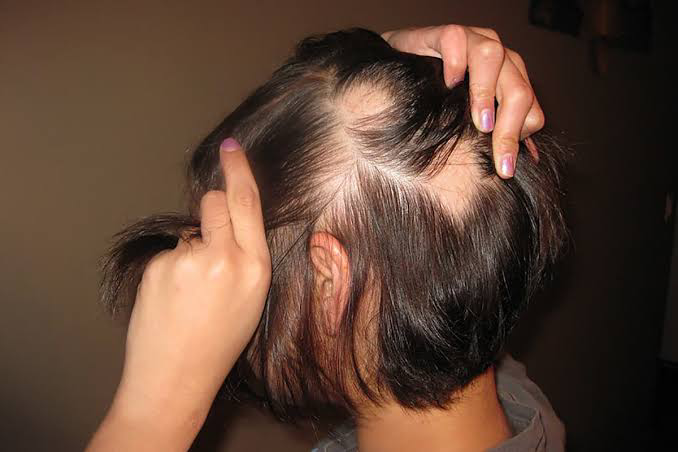Alopecia, also known as alopecia areata, is a persistent skin condition with a complex immune-mediated origin. It manifests as sudden hair loss, affecting the scalp, beard, eyebrows, eyelashes, and body hair, often leading to bald spots or patches. This unpredictable hair loss cycle can be baffling, with hair growth returning and then vanishing again. Remarkably, affected areas exhibit no signs of inflammation or other apparent causes for hair loss.
Alopecia is classified as an autoimmune disorder where the immune system mistakenly attacks hair follicles, leading to decreased hair size, slowed growth, or complete hair loss. The triggers for alopecia involve a combination of genetic and environmental factors. Furthermore, alopecia can frequently be associated with other autoimmune conditions like thyroid disease, systemic lupus erythematosus, psoriasis, rheumatoid arthritis, and various inflammatory diseases.
The Three Types of Alopecia
- Alopecia Areata
Alopecia areata is a hair loss condition caused by the immune system attacking hair follicles. Although alopecia translates to "hair loss," not all forms are autoimmune in nature. Alopecia areata is a non-scarring hair loss condition and is considered an autoimmune disease where the body's immune system turns against itself.
Signs and Symptoms of Alopecia Areata
The primary sign of alopecia areata is sudden hair loss. Some individuals with alopecia areata experience itching, burning, or tingling sensations before hair loss occurs. However, most people with alopecia areata only notice hair loss, often in small round clumps, typically the size of a quarter. This is due to inflammation around hair follicles, rendering them unable to support hair strands.
How do I get Alopecia Areata?
The exact cause of alopecia areata remains elusive, but it tends to occur more frequently in individuals with a family history of the condition or other autoimmune disorders like thyroid disease, lupus, or diabetes. In alopecia areata, the body fails to recognize hair follicles as its own, initiating an immune response that leads to hair loss. It's important to note that alopecia areata is not contagious.
At what age does someone get Alopecia
You can get alopecia areata at any age; however, most people develop it by 30 years of age. For many, the disease begins during childhood or the teenage years.
- Alopecia Universalis
Alopecia universalis represents a rare and severe variant of alopecia areata. While alopecia areata typically causes sporadic patches of hair loss on the scalp, alopecia universalis results in complete hair loss on both the scalp and the entire body. This includes the arms, underarms, legs, pubic area, chest, back, eyelashes, and eyebrows.

How do I get Alopecia Universalis?
Like other forms of alopecia areata, alopecia universalis is regarded as an autoimmune disorder. The immune system mistakenly attacks hair follicles, causing hair to detach from the follicles and inhibiting new hair growth. The exact cause of alopecia universalis, as with other autoimmune diseases, remains uncertain but likely involves genetic and environmental factors.
- Alopecia Totalis
Alopecia totalis is characterized by total scalp hair loss. It is a relatively uncommon condition, affecting only 1 in 2000 individuals. Alopecia totalis is considered an advanced form of alopecia areata, as it shares the same non-scarring nature, with hair regrowth still possible due to the absence of complete hair follicle destruction
Symptoms of Alopecia Totalis
Symptoms of alopecia totalis vary among individuals but generally include excessive hair loss from the scalp. Some may experience itching and scalp tightness, while others exhibit no additional symptoms. Hair loss typically begins with hair thinning and progresses to bald patches. While there are no physical secondary effects, the psychological impact of hair loss can be distressing.
How do I get Alopecia Totalis?
The precise cause of alopecia totalis remains unknown. It is suspected to have genetic and autoimmune origins. The immune system, which typically defends the body, mistakenly targets hair follicles, resulting in inflammation and hair loss. Genetic predisposition plays a role, and stress, although not conclusively proven, may affect the immune system in some cases.

Diagnosing Alopecia
Alopecia areata is primarily diagnosed through a physical examination. Dermatologists assess the scalp, face, body, and nails for signs of hair loss and changes. Blood tests may be ordered to investigate potential concurrent autoimmune conditions, such as thyroid disorders.
To confirm the diagnosis and rule out other conditions, diagnostic tests like microscopic examination of remaining hair strands or skin biopsy may be performed.
Treatment Options
Effective treatments are available for various forms of hair loss, including alopecia areata. Some individuals may experience spontaneous hair regrowth within a year without treatment. Treatment options include medications, surgical interventions, home remedies, and lifestyle changes.
In this blog, we will explore treatment approaches for alopecia, including:
- Reducing Scalp Inflammation
Managing inflammation and alleviating itching and hair loss is essential for alopecia sufferers. Here are some steps you can take:
- Nourishing Your Scalp:
Root2tip’s Long Scalp Growth Serum, developed with essential oils and fruit extracts, provides vital nourishment to your scalp, fostering optimal hair growth conditions. It has been effectively treating dry scalps for over a decade.
- Maintaining Moisture:
Keep your scalp moisturized to prevent hair drying and breakage. Products like Root2tip’s Honey Rain Juice aid in maintaining scalp moisture while detangling and preventing hair breakage.
- Keeping Your Scalp Clean:
Build-up of oil, hair products, dead skin cells, and dirt can clog scalp pores and follicles, leading to irritation and hair loss. Root2tip Stimulate and Cleanse SLS Free Hair Shampoo helps maintain a clean scalp.
- Deep Conditioning:
Chemical hair treatments may leave hair and scalp parched. Consider deep conditioning with Root2tip Original Honey Rain Juice Detangler and TRIPLE Protein Strengthening Hair Mask – Deep Conditioner.
- Maintaining Blood Circulation:
Blood circulation to the scalp is essential for hair growth. Root2tip’s Root Energizer Scalp Oil, based on Ayurvedic extracts, promotes circulation and nourishes the scalp.
- Reducing Stress
Stress is a common trigger for hair loss. To counteract stress and protect your hair, try the following:
- Relaxation Techniques: Practice relaxation techniques like deep breathing, meditation, or yoga regularly.
- Regular Exercise: Engage in regular exercise to manage stress.
- Social Support: Spend time with positive people to combat isolation-induced stress.
- Professional Help: Seek help from a therapist if stress becomes overwhelming.
- Healthy Diet: Consume a nutritious diet and consider multivitamin supplements as recommended by your doctor.
- Gentle Hair Care: Treat your hair gently during washing, drying, and styling to minimize stress-induced hair loss.
In conclusion, understanding alopecia and its various forms is crucial for those affected and their loved ones. This comprehensive guide has shed light on the complexities of alopecia areata, alopecia universalis, and alopecia totalis, explaining their causes, symptoms, and potential treatments.
It’s important to remember that alopecia, while challenging, is a condition that many individuals can manage effectively with the right approach. Whether you’re seeking to reduce scalp inflammation, nourish your scalp, maintain moisture, or promote blood circulation, Root2tip offers products designed to support healthy hair growth and scalp care.
Furthermore, managing stress plays a significant role in the journey to combat alopecia. Incorporating relaxation techniques, regular exercise, and seeking professional help when needed can help alleviate stress and protect your hair.
While there may be no one-size-fits-all solution for alopecia, Root2tip is committed to providing resources and products that empower individuals to take charge of their hair and scalp health.
Remember, alopecia does not define you. With the right knowledge, support, and self-care, you can navigate the challenges of alopecia and embrace your unique beauty. Your journey to healthier, more vibrant hair starts with understanding and taking the steps outlined in this guide.
Thank you for joining us in exploring alopecia and its treatments. We invite you to explore Root2tip’s range of products and resources to embark on your path toward healthier, more beautiful hair. Visit us at www.root2tip.com

